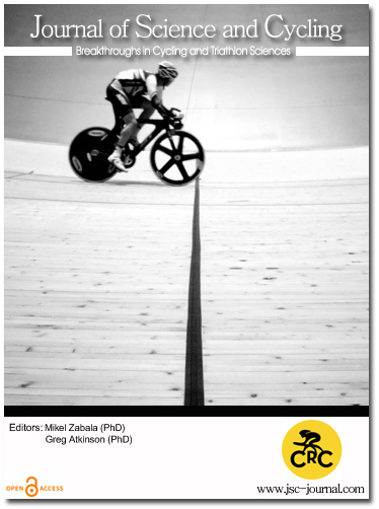Relationship between physiological and biomechanical variables with aerobic power output in Cycling
Keywords:
Power output, oxygen uptake, pedaling techniqueAbstract
Performance in cycling may be determined by physiological and biomechanical parameters. The aim of this study was to assess the relationship between biomechanical and physiological variables with aerobic power output in cycling. Twelve cyclists and twelve non-athletes performed an incremental cycling test to exhaustion during their first evaluation session and a constant load cycling test in a second evaluation session. Aerobic power output and oxygen uptake were measured during the first evaluation session, while muscle volume (determined using ultrasound measures in static conditions) and pedal forces were measured at the second session. Pedal forces were used to compute total force applied to the pedal and force effectiveness. Two multivariate stepwise regression analyses were conducted to measure the relationship between power output and oxygen uptake obtained at the second ventilatory threshold (VT2), muscle volume, total force applied to the pedal, force effectiveness and lower limb muscle activation for cyclists and non-athletes. Only oxygen uptake at the VT2 was significantly related to power output for non-athletes ( ) (r = 0.64, p = 0.03), whereas the resultant force was included in the regression model for cyclists (r = 0.66, p = 0.02). Muscle volume, pedal force effectiveness and muscle activation seem to have a minor effect in aerobic power output during cycling.
Downloads
Published
How to Cite
Issue
Section
Copyright (c) 2014 Journal of Science and Cycling

This work is licensed under a Creative Commons Attribution-NonCommercial 4.0 International License.
Authors contributing to Journal of Science and Cycling agree to publish their articles under a Creative Commons CC BY-NC-ND license, allowing third parties to copy and redistribute the material in any medium or format, and to remix, transform, and build upon the material, for any purpose, even commercially, under the condition that appropriate credit is given, that a link to the license is provided, and that you indicate if changes were made. You may do so in any reasonable manner, but not in any way that suggests the licensor endorses you or your use.
Authors retain copyright of their work, with first publication rights granted to Cycling Research Center.






